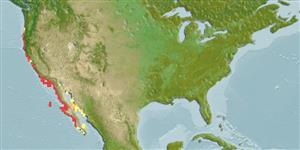Common names from other countries
>
Atheriniformes (Silversides) >
Atherinopsidae (Neotropical silversides) > Atherinopsinae
Etymology: Atherinopsis: Greek, atherina, the Greek name for the eperlane; 1770 + Greek,ops = appearance (Ref. 45335).
More on author: Girard.
Environment: milieu / climate zone / depth range / distribution range
Ecología
marino; rango de profundidad ? - 30 m (Ref. 37955). Subtropical; 46°N - 22°N, 129°W - 110°W
Eastern Pacific: Yaquina Bay in Oregon, USA to southwestern coast of Baja California, Mexico.
Tamaño / Peso / Age
Maturity: Lm ? range ? - ? cm
Max length : 45.0 cm TL macho / no sexado; (Ref. 9273); common length : 40.0 cm TL macho / no sexado; (Ref. 9273); edad máxima reportada: 11 años (Ref. 56049)
Short description
Claves de identificación | Morfología | Morfometría
Espinas dorsales (total) : 6 - 10; Radios blandos dorsales (total) : 11 - 14; Espinas anales: 1; Radios blandos anales: 21 - 26; Vértebra: 50 - 54. Branchiostegal rays: 5-6 (Ref. 36497).
Adults inhabit inshore areas, including bays (Ref. 2850). Form schools (Ref. 2850). Demersal spawners in nearshore habitats (Ref. 56049). Oviparous, with planktonic, primarily neustonic larvae (Ref. 36497). Eggs are attached to one another by spawning substrate via adhesive filaments (Ref. 36497). Sold fresh (Ref. 2850).
Eschmeyer, W.N., E.S. Herald and H. Hammann, 1983. A field guide to Pacific coast fishes of North America. Boston (MA, USA): Houghton Mifflin Company. xii+336 p. (Ref. 2850)
IUCN Red List Status (Ref. 130435)
CITES (Ref. 128078)
Not Evaluated
Threat to humans
Harmless
Human uses
Pesquerías: comercial
Herramientas
Special reports
Download XML
Fuentes de Internet
Estimates based on models
Preferred temperature (Ref.
115969): 12.8 - 24.2, mean 20.7 (based on 122 cells).
Phylogenetic diversity index (Ref.
82804): PD
50 = 1.0000 [Uniqueness, from 0.5 = low to 2.0 = high].
Bayesian length-weight: a=0.00724 (0.00392 - 0.01338), b=3.01 (2.84 - 3.18), in cm Total Length, based on LWR estimates for this species & (Sub)family-body (Ref.
93245).
Nivel trófico (Ref.
69278): 2.3 ±0.21 se; based on food items.
Resiliencia (Ref.
120179): Medio, población duplicada en un tiempo mínimo de 1.4-4.4 años (tm=2.5; Fec = 6,000).
Fishing Vulnerability (Ref.
59153): Low to moderate vulnerability (35 of 100).
